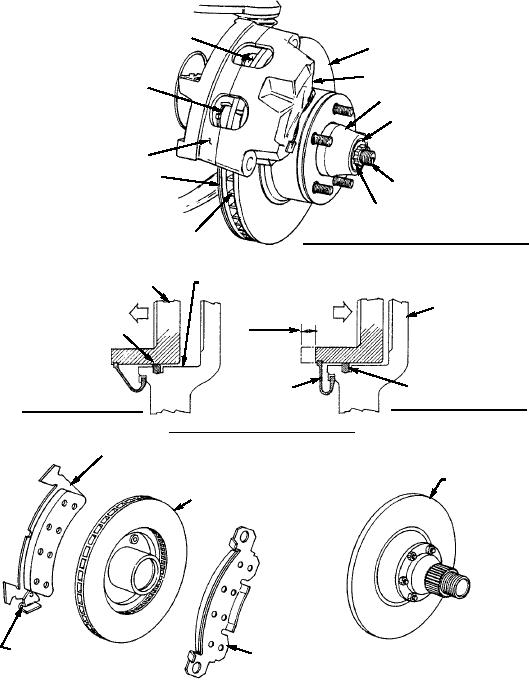
BRAKE LINING (PAD)
BRAKING DISC
OUTER CALIPER HOUSING
BRAKESHOE
HUB
BEARING
INNER CALIPER HOUSING
SPLASH SHIELD
COTTER PIN
NUT LOCK
VENTILATING LOUVERS
TYPICAL DISC BRAKE ASSEMBLY
CYLINDER BORE
PISTON
CALIPER
BRAKES
HOUSING
APPLIED
PISTON SEAL STRETCHED
0.005
PISTON SEAL RELAXED
DUST BOOT
BRAKES RELEASED
BRAKES APPLIED
PISTON BEING RETRACTED
BRAKE PLATE AND LINING
(PAD) ASSEMBLY
NONVENTILATED (SOLID)
DISC ROTOR
VENTILATED DISC
OR ROTOR
ASf02029
BRAKE PAD (LINING)
BRAKE PLATE (SHOE)
WEAR INDICATOR
AND LINING ASSEMBLY
Figure 2-29.--Disc brake assembly.
discard. Do not remove all of the fluid or bleeding of
The next step is to remove the old shoes and insert
the system will be required on reassembly. Then,
the new shoes. Remount the caliper or replace the shoe
remove the shoes following the manufacturer's
retainers, torquing all bolts according to the
procedure. The procedure may vary depending on the
manufacturer's specifications. Refill the master
manufacturer and model. Some models allow removal
cylinder and apply the brakes a few times. Then, check
of the shoes with the caliper mounted on the vehicle,
for any leaks at the pistons in the caliper. If there are no
while other designs require removal of the caliper
leaks, replace the wheels and lower the vehicle. A road
before the shoes can be extracted. In either case, the
test should be made to insure that the brakes are
pistons should be bottomed in the bores of the caliper
working properly and also to seat the new shoes on the
assembly (fully pressed into the caliper) to release any
disc. Several (3 or 4) heavy brake applications at
tension on the shoes. This allows clearance for any rust
approximately 3 to 5 miles per hour will work. If the
buildup (ridge) at the outer edge of the disc.
brakes function normally after the braking test, the job
is complete.
NOTE: The rust buildup near the edge of the disc
may have to be removed for the new shoes to seat
SERVICING CALIPER ASSEMBLIES.--
properly on the disc.
Servicing disc brake caliper assemblies usually
2-21

